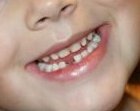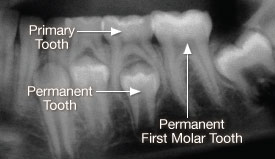
Baby teeth falling out
The fall out of baby teeth is an important stage in the development of human dentition. All baby teeth in humans are lost between the ages of 6-12 years being replaced by their permanent successors. This article will provide the necessary information for better understanding this process, regarding the purpose, timing, and mechanism of baby teeth fall out.
Why baby teeth must fall out?
Human species is classified as diphyodont, meaning that we develop two different sets of teeth in our lives. A first set of 20 baby teeth (also called deciduous milk, temporary, or primary teeth) and a set of 32 adult (secondary or permanent) teeth.
At early childhood our mouths are too small to accommodate a full set of 32 large permanent teeth. Baby teeth are necessary in order to perform all the related functions (chewing and speaking) for the child, and prepare the jaw for the upcoming permanent tooth. They are essential for the proper alignment, spacing and occlusion of the adult dentition. But when their permanent successors are ready to erupt, baby teeth have fulfilled their purpose and it is their natural destination to fall out.
When baby teeth fall out?
A child will start to lose baby teeth at about the age of 6 years. The primary teeth will continue to fall out one by one until around the age of 12-13 years.
Baby teeth will generally fall out following the same pattern in which they have erupted in the mouth. The mandibular central incisors (the bottom front teeth) are the first deciduous teeth expected to be lost, followed by the rest of the incisors, the first molars, the canines, with the second deciduous molars to be the last ones to fall out. Baby teeth loss usually happens in symmetrical pairs, with the same teeth on both sides of a jaw being lost at about the same time.
Normally, a baby tooth will fall out when the permanent tooth that will replace it has completed its formation and it is ready to erupt. The jaws have grown enough to create the adequate extra space required for the eruption of the larger adult teeth. The baby teeth must go away to free this space in the jaw for the adult teeth to come out properly.
Read more for early / late loss of baby teeth
The loss of the last primary molars marks the start of the permanent dentition. For the period starting from the eruption of the first permanent molar until the last baby molars are lost, the child has a mixed dentition with a combination of baby and permanent teeth.
The following tooth loss chart displays the average timeframe when baby teeth fall out:
| Tooth Type | Age when baby teeth fall out |
| Central Incisors | 6 to 7 years old |
| Lateral Incisors | 7 to 8 years old |
| Cuspids | 9 to 12 years old |
| First Molars | 9 to 11 years old |
| Second Molars | 10 to 12 years old |
How baby teeth fall out?
The permanent first molars are the first teeth of the adult dentition to erupt, but they are non-succedaneous teeth meaning that they do not replace an existing baby tooth. The first succedaneous teeth are the permanent lower central incisors which replace their primary predecessors.
Succedaneous teeth such as the permanent incisors, canines, and premolars can erupt properly only if the baby tooth that they are about to replace has first fall out (exfoliated). In order for the baby teeth to fall out naturally, around one year earlier their roots start ‘melting away’. This process of root dissolving is referred as resorption. Generally, resorption begins at the tip of the tooth’s root and moves toward the crown.
When baby teeth erupt, the tooth buds of the permanent teeth that will later take their place already exist in the jaws. They are located close to the roots of the primary teeth, either next to them for incisors and canines, or between the roots of primary molars for the permanent premolars.
 As the crown of a permanent tooth reaches its final stages of formation, cells known as osteoclasts start to resorb (dissolve) the root of the baby tooth.
The permanent tooth continues to grow and move towards the gums taking the space freed by the already dissolved part of the baby tooth’s root.
As the crown of a permanent tooth reaches its final stages of formation, cells known as osteoclasts start to resorb (dissolve) the root of the baby tooth.
The permanent tooth continues to grow and move towards the gums taking the space freed by the already dissolved part of the baby tooth’s root.
When the root structure of the baby tooth is almost entirely dissolved, the remaining tooth becomes loose and finally it falls out. The root has completely resorbed by the time the permanent tooth below it is ready to erupt. This event is known as exfoliation.
If, for any reason, the primary tooth root resorption fails to complete, it will not fall out as expected. In this case, the permanent tooth may erupt in an abnormal position, or may completely fail to erupt. The baby tooth must be removed (extracted) by the dentist to allow the eruption of the permanent tooth.
Six years old children will soon notice that their lower front teeth have started to be easily movable. Normally, the tooth will simply fall out painlessly in a few days without causing any serious problem to the child. Kids should be encouraged to move the specific tooth back and forth with their hand or their tongue in order to help it loosen up faster. Baby teeth should not be forcefully pulled out before they are ready to shed naturally, unless there is a problem with their normal exfoliation. In this case the baby tooth is better to be removed by a pediatric dentist.
The baby teeth play an important role in the proper development and positioning of permanent teeth. Either the premature or late loss of baby teeth can cause serious implications in the eruption of permanent teeth.
- More articles about Baby Teeth


